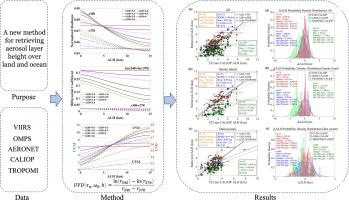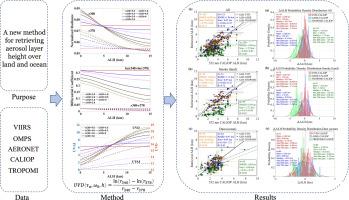利用紫外线双波长测量方法探测陆地和海洋上空烟尘气溶胶的层高
IF 11.4
1区 地球科学
Q1 ENVIRONMENTAL SCIENCES
引用次数: 0
摘要
大气气溶胶的垂直分布对气候变化、空气质量、云-气溶胶相互作用、大气遥感和全球运输具有重要影响。然而,目前基于被动辐射测量的气溶胶层高度(ALH)反演算法在很大程度上受地表反射率的影响,限制了其对低反射率表面(如海洋和暗目标地表)的适用性。气溶胶单散射反照率和层高估算(ASHE)算法可以很好地适应陆地和海洋,但受气溶胶光学深度(AOD)不确定性的影响较大,并且需要估计预期的无气溶胶辐射。为了降低AOD不确定度的影响,简化方法,提出了一种紫外波段差商系数(UVD)法。首先,在检索过程中,结合UV气溶胶指数(UVAI)、AOD和Ångström指数(AE)进行云层筛选和气溶胶类型分类(烟雾和粉尘区分)。接下来,利用瑞利散射的高灵敏度和气溶胶吸收的波长依赖性,利用紫外双波段归一化辐亮度lnr340−lnr378lnr340−lnr378的对数差值捕捉并放大ALH对辐亮度差值的影响。通过引入两波段差r340−r378r340−r378的归一化效应,部分抵消了AOD不确定度的影响,使得UVD对ALH的响应单调、稳定、灵敏。最后,建立烟尘气溶胶查找表(LUTs)来检索ALH。UVD方法得到了CALIOP观测结果的验证,CALIOP观测数据来自一系列记录良好的北美生物质燃烧事件和大西洋沙尘暴。验证结果表明,RMSE范围为0.67 ~ 1.42 km(平均0.99 km),偏差范围为- 0.62 ~ 0.57 km,相关系数为0.71。UVD-CALIOP的误差分布集中在−1 km ~ 1 km范围内,75%的数据点误差在1.13 km以内。本文章由计算机程序翻译,如有差异,请以英文原文为准。


Detecting the layer height of smoke and dust aerosols over land and ocean using ultraviolet dual-wavelength measurements
Vertical distribution of atmospheric aerosols has a significant impact on climate change, air quality, cloud-aerosol interactions, atmospheric remote sensing, and global transport. However, current aerosol layer height (ALH) retrieval algorithms, based on passive radiometry, are largely affected by surface reflectance, limiting their applicability to surface with low reflectance, for example, ocean and dark-target land surfaces. The Aerosol Single-scattering albedo and layer Height Estimation (ASHE) algorithm can be well adapted to both land and ocean, but it is strongly influenced by aerosol optical depth (AOD) uncertainty and requires estimation of expected aerosol-free radiation. In order to reduce the effects of AOD uncertainty and to simplify the method, a UV band difference quotient coefficient (UVD) method is developed in this study. First, in the retrieval process, UV aerosol index (UVAI), AOD, and Ångström exponent (AE) are incorporated to perform cloud screening and aerosol type classification (distinguishing between smoke and dust). Next, utilizing the high sensitivity of Rayleigh scattering and the wavelength dependence of aerosol absorption, the logarithmic difference of UV dual-band normalized radiance is used to capture and amplify the impact of ALH on radiance differences. By incorporating the normalization effect of the two-band difference , the effects from AOD uncertainty are partially offset, resulting in a monotonic, stable, and sensitive response of the UVD to the ALH. Finally, lookup tables (LUTs) for smoke and dust aerosols are built to retrieve ALH. The UVD method was validated using CALIOP observations from a series of well-documented North American biomass burning events and Atlantic dust storms. The validation results indicate that the RMSE ranges from 0.67 to 1.42 km (mean: 0.99 km), while the bias varies between −0.62 and 0.57 km, with a correlation coefficient of 0.71. Additionally, the error distribution of UVD-CALIOP is concentrated within the range of −1 km to 1 km, with 75 % of the data points having an error within 1.13 km.
求助全文
通过发布文献求助,成功后即可免费获取论文全文。
去求助
来源期刊

Remote Sensing of Environment
环境科学-成像科学与照相技术
CiteScore
25.10
自引率
8.90%
发文量
455
审稿时长
53 days
期刊介绍:
Remote Sensing of Environment (RSE) serves the Earth observation community by disseminating results on the theory, science, applications, and technology that contribute to advancing the field of remote sensing. With a thoroughly interdisciplinary approach, RSE encompasses terrestrial, oceanic, and atmospheric sensing.
The journal emphasizes biophysical and quantitative approaches to remote sensing at local to global scales, covering a diverse range of applications and techniques.
RSE serves as a vital platform for the exchange of knowledge and advancements in the dynamic field of remote sensing.
 求助内容:
求助内容: 应助结果提醒方式:
应助结果提醒方式:


